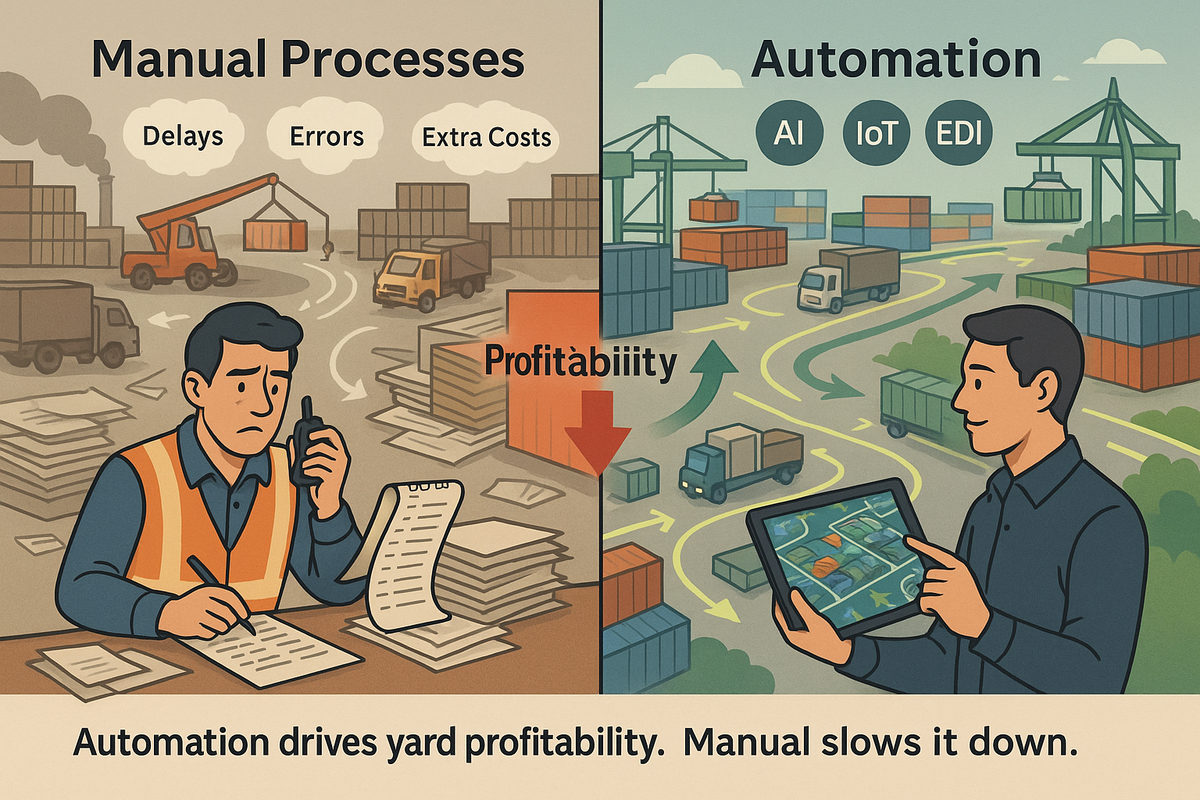Why 200-TEU Depots Need CTMS: Hidden Costs of Manual Work
Automation vs. Manual Processes: The True Impact on Yard Profitability
Meta Description: Discover why automation outperforms manual processes in container yards. From hidden costs to ROI, learn how digital tools maximize terminal efficiency and profitability.
How Automation Transforms Yard Profitability Compared to Manual Work
Intro
Many container depots and terminals still rely on Excel spreadsheets, clipboards, and phone calls to manage daily operations. Manual work feels cheaper at first glance — no need to invest in specialized software or train staff on new systems. But hidden behind the surface are inefficiencies that silently eat into profitability. The real question for modern yard operators is this: does sticking with manual processes save money, or does automation unlock the real potential of profitability?
The Hidden Costs of Manual Work
Manual operations may look simple, but they carry a long list of invisible expenses. Every day, staff spend hours retyping container numbers into multiple systems, searching for misplaced records, and correcting double entries. Each error might seem small, but together they become a constant drain on resources.
For example, a dispatcher might spend 40 minutes locating a container that was mistakenly recorded in the wrong row. A billing clerk may need half a day to fix duplicated invoices after cross-checking paperwork with spreadsheets. Such repetitive inefficiencies create an illusion of work being “done,” while in reality money and time are wasted.
Human error is another major issue. A single mistyped container number can cause delays for trucking companies, create disputes with shipping lines, and force staff into hours of manual corrections. Staff fatigue multiplies the risks, especially during peak hours when trucks line up at the gates. Instead of scaling operations, manual processes often slow down growth and increase reliance on overtime.
What Automation Brings to the Yard
Automation replaces guesswork with clarity. A Container Yard Management System (CYMS) provides real-time visualization of the yard, where dispatchers can see container positions instantly, update statuses with a click, and track truck movements as they happen.
With automated billing, invoices are generated the moment a service is completed. Errors from manual calculations disappear, and accounting teams can shift focus to analysis instead of corrections. Gate-in and gate-out operations become smoother — drivers no longer wait for paperwork to be verified manually. Instead, the system checks all details instantly, reducing congestion and improving truck turnaround times.
Operators also benefit from transparent workflows. Every container movement is logged automatically, meaning clients can request status updates without staff having to dig through folders or Excel files. This improves customer trust and helps terminals position themselves as reliable partners.
Efficiency and Profitability: A Side-by-Side Comparison
| Metric | Manual Processes | With Automation |
|---|---|---|
| Container search time | 20–40 minutes | 2–3 minutes |
| Error rate in documentation | 10–15% | <1% |
| Billing accuracy | Frequent disputes | Automated, 99% |
| Truck turnaround time | 40–60 minutes | 20–30 minutes |
Operator Experience and Safety
Automation doesn’t only improve numbers — it changes the human side of operations. Yard operators working manually often face high stress: constant phone calls, piles of paperwork, and unclear container positions. Mistakes are punished with long corrections, and fatigue leads to even more errors.
With automation, the workload shifts from chasing information to making decisions. Dispatchers monitor a live yard map, drivers receive instructions digitally, and shift managers can analyze performance in real time. This reduces stress, creates a safer working environment, and minimizes the risk of accidents caused by miscommunication.
Long-Term ROI of Automation
The true impact of automation is measured not in weeks but in years. While initial investment in CYMS may seem high, the return on investment is often achieved within 6–12 months. The reasons are simple:
- Reduced labor costs: fewer hours wasted on manual corrections and paperwork.
- Higher throughput: the same terminal area can process more containers without expanding physical capacity.
- Fewer disputes: accurate billing means less revenue leakage and faster payments.
- Scalability: when container flows increase, automation absorbs the growth without requiring proportional staff expansion.
For instance, a 500 TEU yard running on manual spreadsheets may struggle to process 40–50 truck moves per day. With automation, the same yard can handle 70–80 moves, improving both customer satisfaction and revenue streams.
Conclusion
Manual processes might look cheaper, but they represent a false economy. Each error, each delayed truck, and each lost invoice slowly chips away at profit margins. Automation provides speed, accuracy, and transparency — three ingredients that drive real profitability. For terminal owners aiming to grow in today’s competitive logistics market, shifting from manual spreadsheets to automated CYMS is not just an option. It is a strategic necessity.
